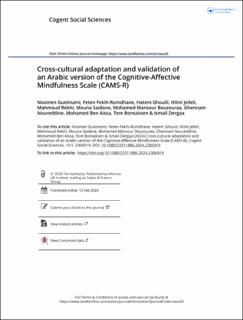| dc.contributor.author | Guelmami, Noomen | |
| dc.contributor.author | Fekih-Romdhane, Feten | |
| dc.contributor.author | Ghouili, Hatem | |
| dc.contributor.author | Jelleli, Hilmi | |
| dc.contributor.author | Rebhi, Mahmood | |
| dc.contributor.author | Saidane, Mouna | |
| dc.contributor.author | Bouzouraa, Mohamed Mansour | |
| dc.contributor.author | Noureddine, Ghennam | |
| dc.contributor.author | Ben Aissa, Mohamed | |
| dc.contributor.author | Bonsaksen, Tore | |
| dc.contributor.author | Dergaa, Ismail | |
| dc.date.accessioned | 2024-03-27T08:28:38Z | |
| dc.date.available | 2024-03-27T08:28:38Z | |
| dc.date.created | 2024-02-15T10:02:37Z | |
| dc.date.issued | 2024 | |
| dc.identifier.citation | Cogent Social Sciences. 2024, 10 (1), 1-15 | en_US |
| dc.identifier.issn | 2331-1886 | |
| dc.identifier.uri | https://hdl.handle.net/11250/3124310 | |
| dc.description.abstract | No arabic version of the Revised cognitive-affective Mindfulness Scale (caMS-R) was found, prompting this study’s threefold objectives: first, to validate an arabic translation of caMS-R among tunisian students; second, to assess its factor structure and reliability; and third, to explore its validity by investigating the relationship between caMS-R scores, grit, and academic success. cross-sectional online data were collected from 705 university physical education students (mean age 21.62 ± 1.38 years) in two distinct time periods, with participants divided into exploratory and confirmatory samples. the 12-item caMS-R scale underwent both exploratory factor analysis and confirmatory factor analysis (cFa), confirming a second-order structure (χ2 (53) = 77.997, p = 0.014; χ2/df = 1.47; comparative fit index (cFi) = 0.995; cFi = 0.994; RMSea (90% confidence interval [ci] 0–0.013–0.042) = 0.029. Strong internal consistency was indicated by cronbach α indices ranging from 0.865 to 0.880 for all subscales. Results from Roccurve analysis revealed the arabic caMS-R’s ability to distinguish effectively between students with low and high-grade point averages (gPa; area under the curve [aUc] = 0.782, ci 95%: 0.726–0.838, p < 0.001), confirming its sensitivity. convergent and discriminant validity were supported by the average variance extracted (aVe) of the four scale factors and adherence to the Fornell and larcker discriminant validity criterion. additionally, caMS-R scores displayed positive associations with gPa and grit scores, establishing the concurrent validity of the scale. in conclusion, these findings collectively suggest that the arabic version of caMS-R is a recommended self-report assessment tool for mindfulness in tunisia and other arabic countries. | en_US |
| dc.language.iso | eng | en_US |
| dc.publisher | Cogent OA | en_US |
| dc.rights | Navngivelse 4.0 Internasjonal | * |
| dc.rights.uri | http://creativecommons.org/licenses/by/4.0/deed.no | * |
| dc.subject | arabic | en_US |
| dc.subject | psychometric properties | en_US |
| dc.subject | grit | en_US |
| dc.subject | students | en_US |
| dc.subject | Cognitive-Affective Mindfulness Scale | en_US |
| dc.subject | mindfulness | en_US |
| dc.title | Cross-cultural adaptation and validation of an arabic version of the cognitive-affective mindfulness scale (CAMS-R) | en_US |
| dc.type | Peer reviewed | en_US |
| dc.type | Journal article | en_US |
| dc.description.version | publishedVersion | en_US |
| dc.rights.holder | © 2024 The Author(s). Published by Informa UK Limited, trading as Taylor & Francis Group | en_US |
| dc.source.pagenumber | 1-15 | en_US |
| dc.source.volume | 10 | en_US |
| dc.source.journal | Cogent Social Sciences | en_US |
| dc.source.issue | 1 | en_US |
| dc.identifier.doi | 10.1080/23311886.2024.2306919 | |
| dc.identifier.cristin | 2246266 | |
| cristin.ispublished | true | |
| cristin.fulltext | original | |
| cristin.qualitycode | 1 | |

